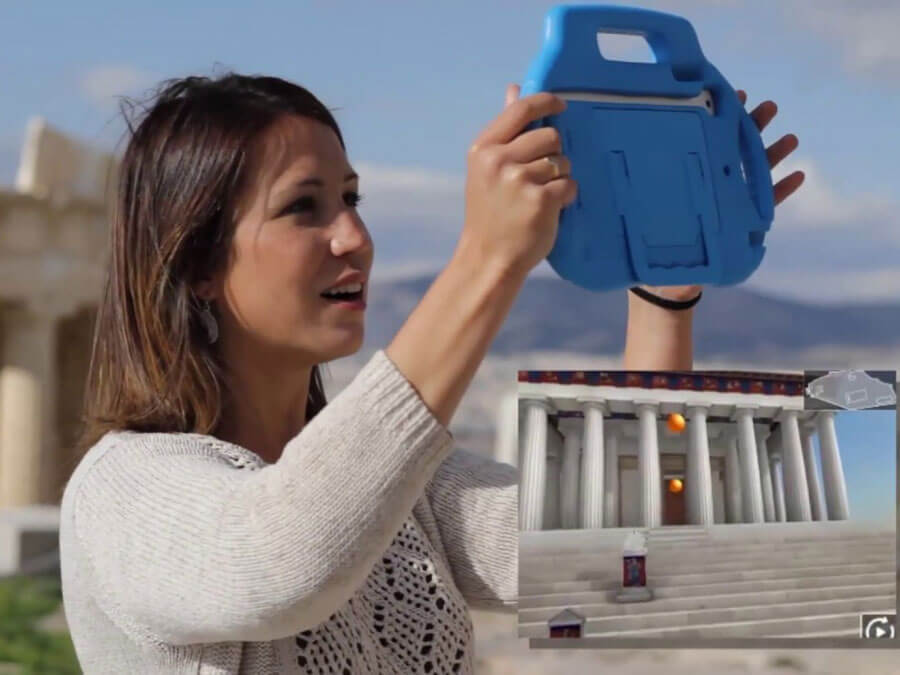The Parthenon: A brief history
Before we move on to the surprising facts, let’s go through some of the most important historic facts about the Parthenon. The double Doric temple pavilion presents many original and unique elements in its architectural design. The temple was designed by Iktinos and Kallikrates, two ancient Greek architects. The responsibility of the sculptural decoration and the ivory statue of Athena, which was inside, as well as the entire construction program of the temple, was the responsibility of the famous sculptor Pheidias. The first attempts for the preservation and restoration of the Parthenon took place as early as 1896-1900 and in 1922-1933 its second restoration program took place. When you visit the Acropolis Hill, don’t be surprised when you witness some of the temple’s brilliant marbles behind scaffolds; maintenance and restoration works of the monument are almost always in progress.
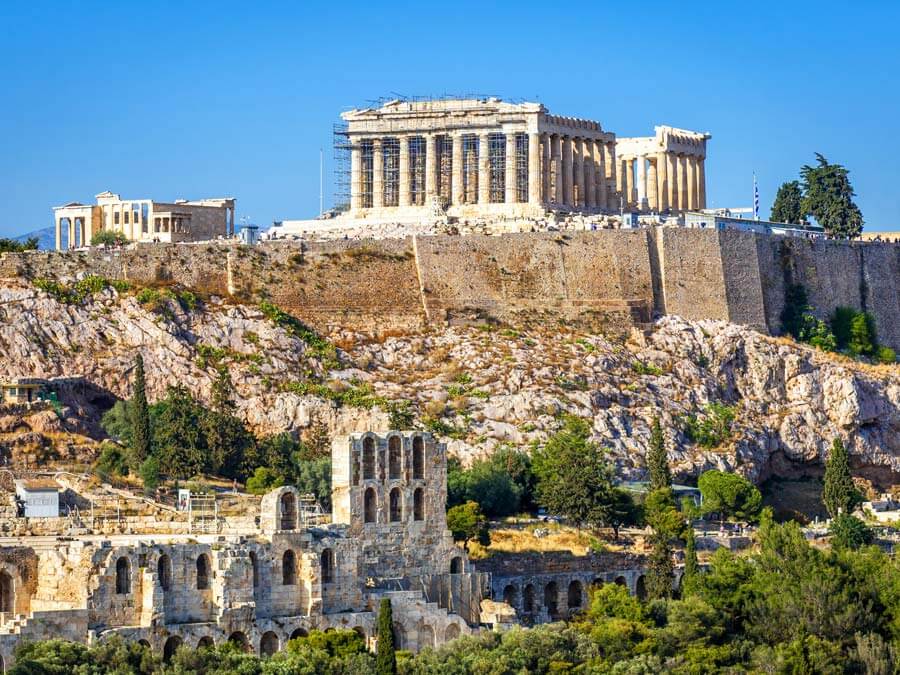
Do you love Greek mythology? Join an Acropolis Mythology Tour, guided by a local expert.
Fact #1: There was another Parthenon before this temple
The Parthenon was built on top of a former temple of Athena, which was destroyed by the Persians during the Persian Wars. In the 6th c. BC, a new temple was built, decorated with sculptures that are exhibited in the Acropolis Museum. After the battle of Marathon, in 490 BC, a marbled temple began to be built around the old one but it was destroyed in 480 BC by the Persians. The Parthenon we can see today was built on the site of this previous temple. Constructions began in 447 BC. and were completed in just nine years (record time for that period)! The decoration works started in 438 and ended in 432 BC.
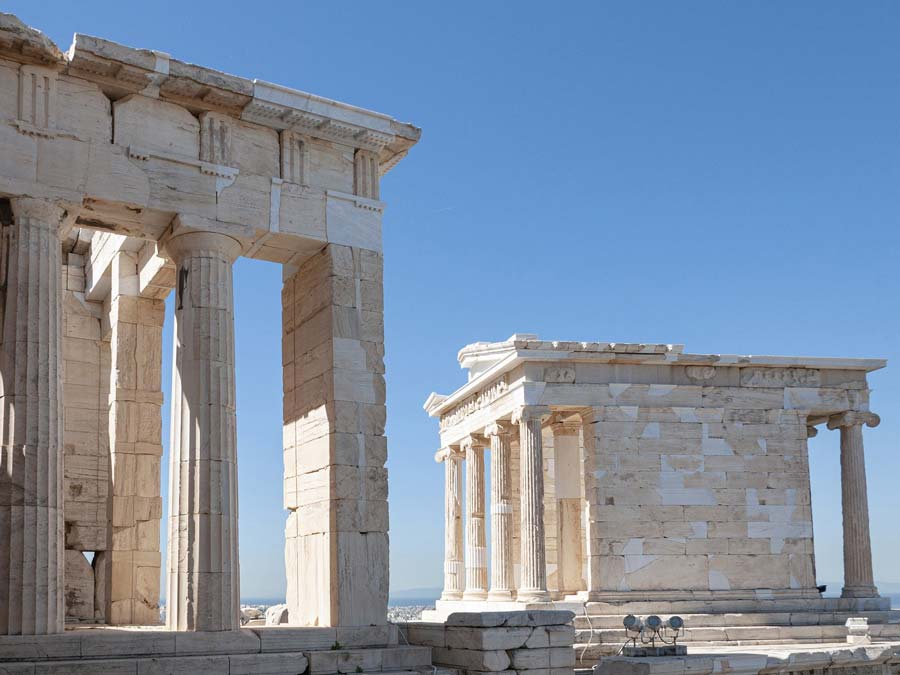
Fact #2: The Parthenon served as a temple in various religions
The Parthenon was dedicated to Goddess Athena, and took its name from one of her many qualities, being a Virgen Goddess (in Greek “parthenos"), thus Parthenon! The temple was serving her and the ancient religion of the Greek Pantheon. Faithful of the Olympian Gods continued to worship the Virgin Athena until the 5th c. AD, when it was transformed into a Cristian temple dedicated initially to Hagia Sophia and later to the Virgin Mary. It was the period when Christianity was expanding and the new religion wanted to conquer the old gods by building symbolically on the ruins of the ancient temples. Though the temple’s fate was adventurous it never lost its religious status. During the years of the Ottoman rule, it became a mosque! Today, it serves as an “open” museum accepting everyone from any land and any religion.
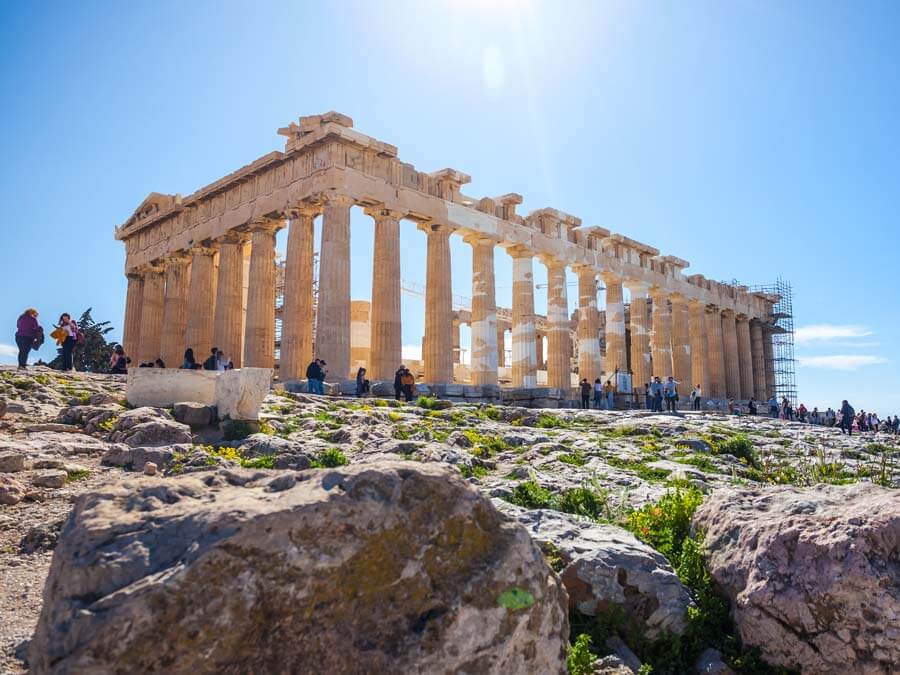
Fact #3: The Parthenon was originally quite colorful
All the data that historians and archaeologists have at their disposal show that the Parthenon did not have the white color we see today. Instead, it was painted in many bright colors! Until the beginning of the 19th century, the systematic excavation of ancient Greek sites had brought to the fore a plethora of sculptures, some of which had visible traces of colorful surfaces. Despite the findings, the most important art historians of the time, such as Johann Joachim Winckelmann, rejected the theory of colorful Greek sculpture to such an extent that the proponents of the theory were considered eccentric and their views unorthodox. However, the scientific method and persistence of the German archaeologist Vinzenz Brinkmann at the beginning of the 21st century founded and proved the theory of colorful Greek sculpture. Using high-intensity light bulbs, ultraviolet light and specially designed cameras, Brinkmann proved that all of the Parthenon sculptures were painted! Imagine that!
Tip! It is now possible to tour Acropolis and admire interactively the ancient site on its full glory and color, with the aid of 3D reconstruction and virtual reality!
Fact #4: A big part of the Parthenon was blown up
A very interesting fact about the Parthenon is that it was attacked several times during its long life. Some of those blows were very destructive and are responsible for the extended damages that we can see today. The first destruction of the Parthenon took place in 267 AD by the Heruli (a people possibly of Scandinavian origin), who occupied Athens and set fire to the Parthenon. The original roof was destroyed as well as the entire internal colonnade. In 1687 AD, a shooting hit the powder storage room that Ali Aga had installed in the site, destroying most of the temple at its east side. During the Greek Revolution of 1821, the Acropolis was liberated by the Greeks, but would later be besieged by the army of Kioutachis Pasha, with more damages at the temple. Nonetheless, the Parthenon still stands evocative and majestic, even if it lost some of its original finesse.

Fact #5: The Parthenon is earthquake-resistant
You may wonder, how come this grand temple on top of a very seismogenic terrain could last more than 2 millennia? The secret that keeps the Parthenon still standing proud, without the slightest damage from the earthquakes that have taken place all those years, has been revealed. Studies have shown that despite the fact that the structure has no foundation, it has triple anti-seismic shielding! That successfully opposes the theory of modern civil engineering, because without even having a foundation, it is triple seismically insulated. This triple insulation is located in different parts of the building. The first point is located on the layers of huge horizontal and extremely smooth marbles on which the Parthenon steps. The second is observed in the metal elastic joints which connect the plates of each layer, and in the center of which are located small iron piles around which lead has been poured (lead has the property of protecting the iron from rust and weakens with its elasticity and absorb any wave, since part of its kinetic energy is converted into heat). And the third is located in the columns of the building, which were not placed in one piece, since the ancient Greeks knew that in order to withstand the vibrations of the earth, they had to be placed in slices of marble, perfectly applied to each other. The result of this triple insulating formula, as Mrs. Timotheou noted, was that the surface seismic waves moved one layer of the marble slabs on top of the other, at the same time that the joints released the kinetic energy developed by the eclipse. The columns - finally - in the way they were placed, allowed the whole building to oscillate but not collapse!

Fact #6: The origin of the Parthenon’s name
The word “parthenos" in ancient Greek meant “virgin”. In the Greek Pantheon, there were two goddesses that were known for their purity and were also called with the epithet “Virgin”; Artemis, the goddess of hunting and wild nature, and Athena, the goddess of warfare strategy and wisdom. Since the temple was dedicated to goddess Athena, it is reasonable to consider that the Parthenon took its name from the epithet of the Virgin Goddess. However, it has also been suggested that the name of the temple may come from the virgins, whose sacrifice ensured the security of the city. The architects Iktinos and Kallikratis seem to have referred to the building as "Hekatompedos" in their lost treatise on Athenian architecture. Moreover, during the 4th century onwards, the building is referred to as “Hekatompedos" or "Hekatompedon", as well as " Parthenon".
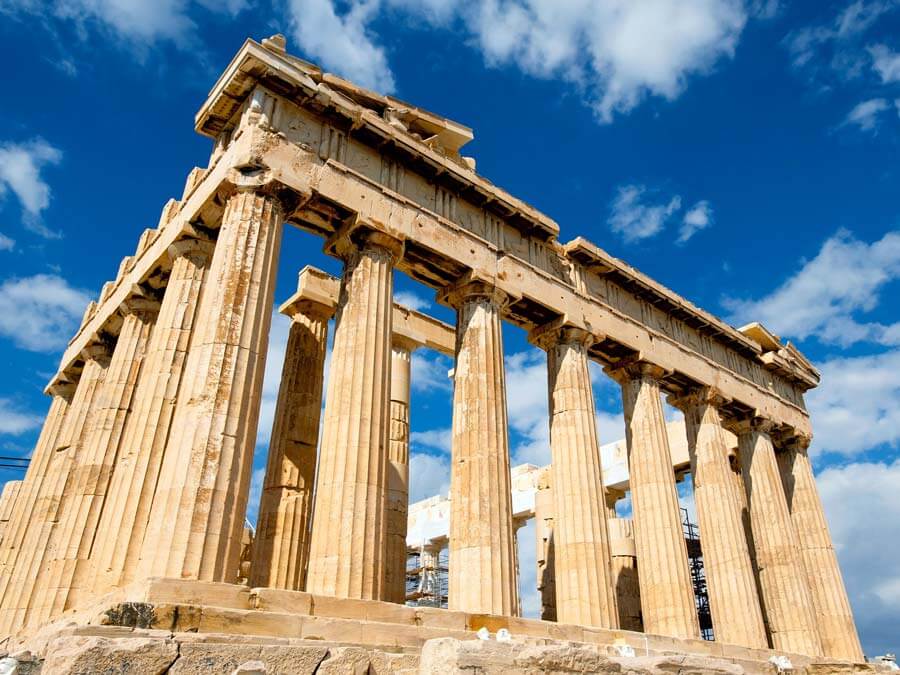
Fact #7: The Parthenon tells stories of Athenian life through its marbles
The sculptural decoration of the Parthenon is a unique masterpiece in the history of world art and is organized in three distinct sections: the metopes, rectangular slabs with relief scenes in the exterior of the colonnade, the frieze at the top of the walls of the nave from the entablatures of the inner columns, and the pediments, which were adorned with compositions of all-sculpted statues.
The Parthenon Metopes
It is an interesting fact to note that the Parthenon is the only temple that has representations on all metopes. The reason we do not find representations in all of the metopes of other temples is purely economic – to cut costs. The ancient Greek sculptor, Pheidias, depicted four themes with mythical battles that symbolized the victorious struggles of the Athenians and are interpreted as follows: on the east, we have the Battle of the Giants (the Gigantomachy), on the west the Battle of the Amazons, on the south the Centauromachy (the battle between the Lapiths and the Centaurs), and on the north possibly scenes from the Trojan War. The four themes actually capture the conflict between two worlds. On the one hand the barbarity and the domination of instincts, that is expressed with the Giants, the Amazons, the Centaurs and the Trojans, and on the other hand the culture, the kindness and the reasoning that the Greek ideals express.
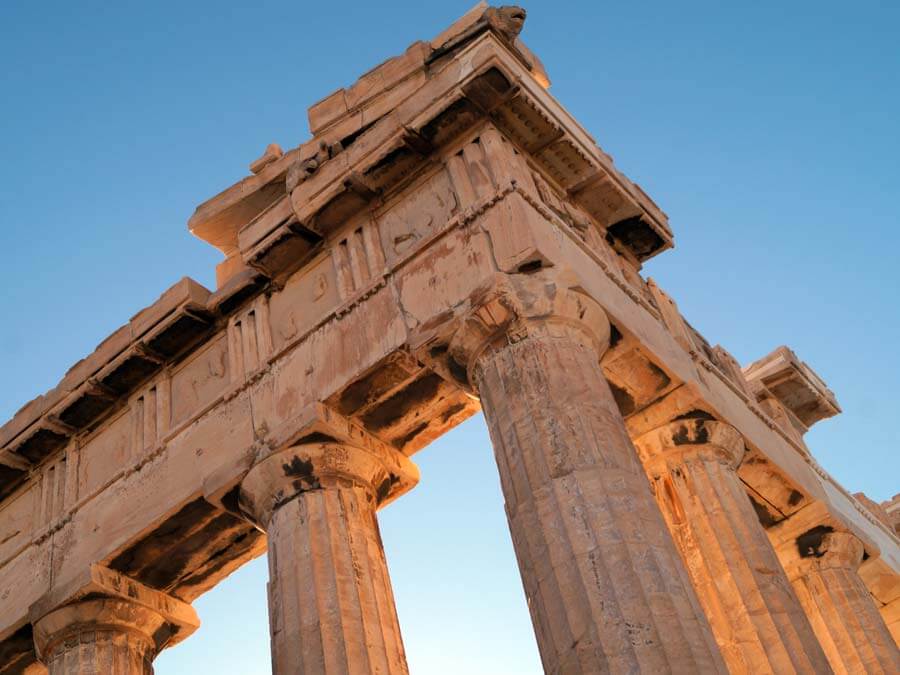
The Gigantomachy
On the east side of the temple, there were 14 metopes. Their subject is the Battle of the Giants. According to Greek mythology, the Giants were the children of the primordial gods Gaia and Uranus. Gaia gave birth to them to avenge Zeus, because he had imprisoned her other children, the Titans, in Tartarus. They were creatures of immense size and power, and could be defeated only outside their territory. Zeus’ child, the demi-god Hercules, helped the Olympians in that epic battle.
The Centauromachy
On the south side of the temple, there were 32 metopes. Of these, 23 depict scenes from the Battle of the Centaurs with the Lapiths, and the other 9 various subjects. According to the legend, Pirithous and his friend Theseus were the ones who brought the Lapiths from Thessaly. Pirithous, to celebrate his marriage to Hippodamia, had a party to which he invited the Centaurs, who were his relatives. When the Centaurs got drunk, one of them, Eurytos, tried to rape the fiancée of Pirithous. Eurytos was imitated by other Centaurs and the marriage ended in conflict. The result was that many were lost on both sides. In the end, the Lapiths won, forcing the Centaurs to leave Thessaly. It is said that Theseus, the founding father and hero of Athens, also took part in the battle, as a friend of Pirithous.
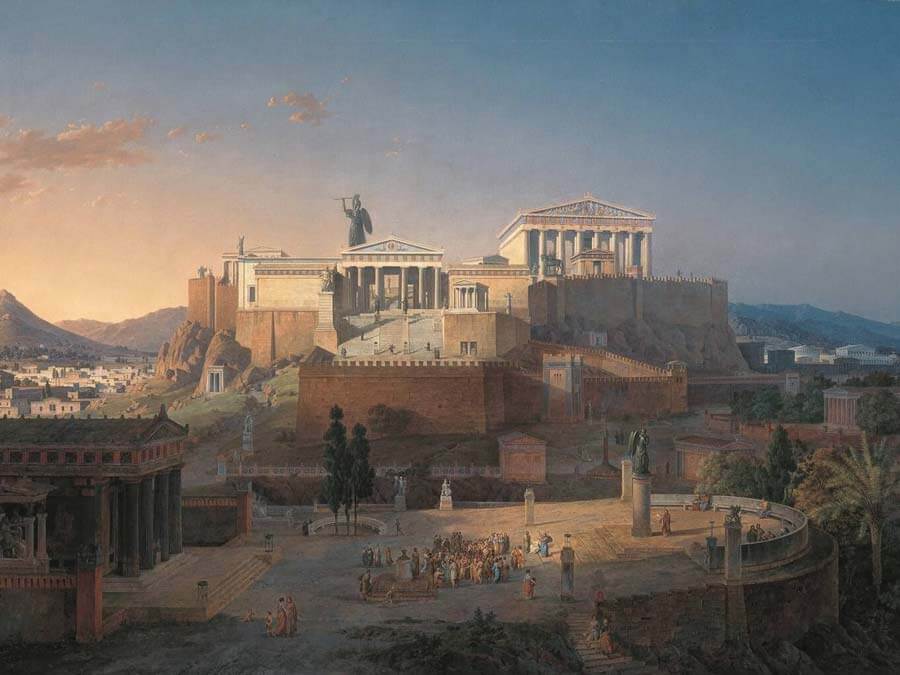
The Great Panathenaea
The composition of the Parthenon Frieze generally represents the procession of the Great Panathenaea, the biggest celebration in honor of the patron goddess of Athens, Athena. It was celebrated every 4 years on her birthday (the 28th of the month Hekatombaion). The final event of the celebration was the procession that carried the new veil of the goddess, embroidered with a representation of the Battle of the Giants, to the Acropolis hill. The procession started from the southwest corner of the temple, in two groups that moved along the north and the south side, to meet in the east, where the tradition of the veil for the cult statue of the goddess was depicted before the Olympian gods. It is believed that the frieze depicts the first-ever procession of Panathenaea or the first after the destruction of the Acropolis by the Persians.
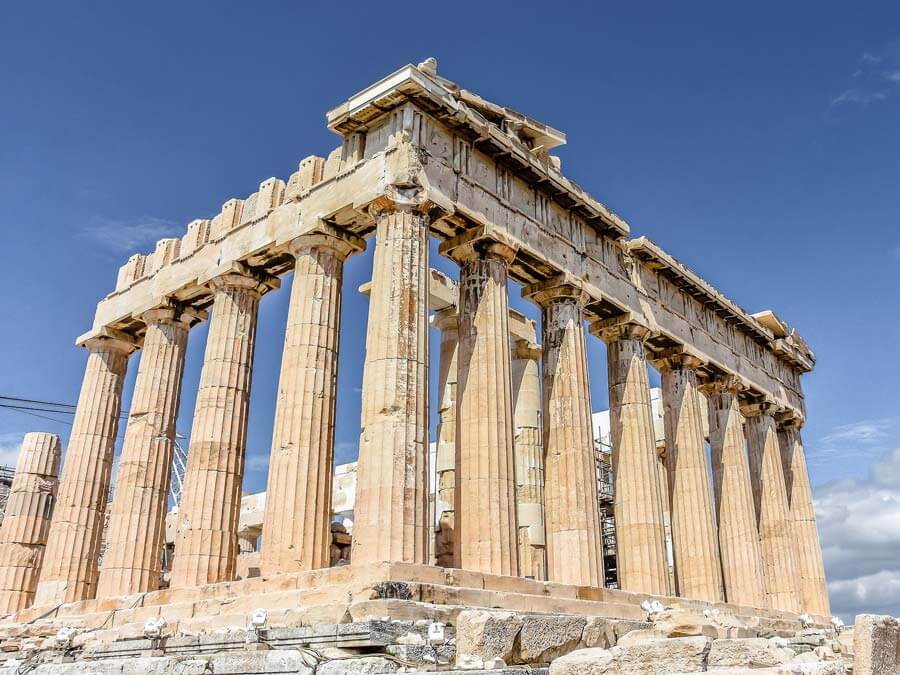
Fact #8: The Parthenon housed a colossal statue of Athena
The Parthenon was built in honor of the patroness of the city, goddess Athena, and was designed to fit her colossal ivory statue inside. Athena’s statue was placed on a pedestal in the nave of the temple and the core of the statue was made of wood. Pheidias used ivory for the naked parts of the body and for the garment and the hair he used gold weighing 1,140 kilos! Goddess Athena appeared in full armor, looking to the east and holding in her right hand the goddess of victory Nike and in her left hand her shield and spear. The statue was 13 meters high and was equal to the glory and power of Pericles' Athens. Athena Parthenos, like most of Pheidias' works, was a masterpiece. She wore an Attic helmet decorated with mythical animals, a Doric veil and inside her shield was her sacred snake. Throughout the creation, as in the temple of the Parthenon, there were representations of the gigantomachy, the centauromachy and the battle of the Amazons. The Athenians had the opportunity to admire it only during the festivities of the city. It was probably destroyed in the 3rd century AD from a fire that broke out inside the temple.
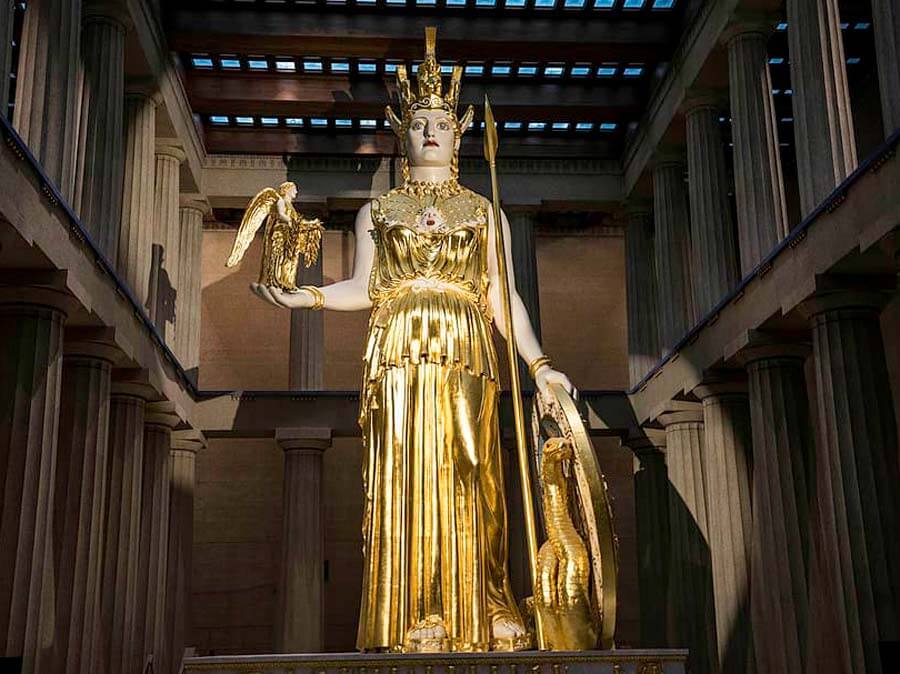
Fact #9: The architecture of the temple is unique
Another interesting fact about the Parthenon is related to its architectural characteristics. The external dimensions of the temple are a perfect golden rectangle and it is believed that the temple was built with great precision, according to this mathematical analogy of the so-called ‘sacred geometry’. The optical illusions are the strongest feature of the temple. Although its columns are discreetly closed inwards to offer a better angle of view from a low point of view, it can effectively eliminate rainwater and have the required seismic reinforcement, due to a very thin productive curve. This architectural marvel has another innovation as well. As it was customary, the Doric temples had 6 columns for the narrow sides and 14 for the long ones. However, in the Parthenon, we have 8 columns on the narrow sides and 17 columns on the long ones. The larger number of columns would create an aesthetic problem if the usual diameter and the usual distance from each other were maintained, which is why the columns became thinner and placed denser. Each column has a height of 10.43 m and an average diameter of 1.91 m. Each consists of 11 vertical pieces. In order to avoid the problems created by the density of the columns in combination with the epistle on the narrow sides, the following solution was found: the distance of the first end of the column from the second is less than the distance of the second and the third. The column is thinner towards the top, but this thinning is done in a dissimilar way. About 1/3 of its height shows a bulge called tension. The intensity gives the impression of a living organism that "suffers" from the weight it lifts.
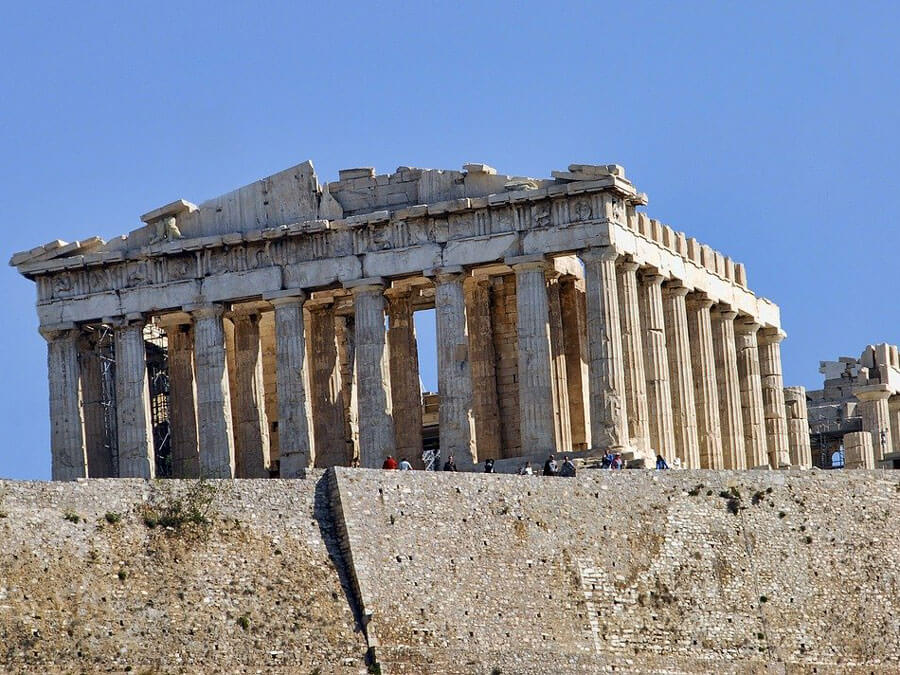
Fact #10: Some of the Parthenon marbles were taken
The beginning of the 19th century was a dark page in the history of the Parthenon and other Greek monuments. At the time, Greece was under Ottoman rule. The British ambassador in Athens was Thomas Bruce, also known as Lord Elgin, and he immediately set his eyes on the grandeur Acropolis. As it was difficult to approach the Acropolis and the Parthenon at that time, it took six months to allow Elgin's team to enter. The group set up the scaffolding, however, rumors had it that shortly after the Turkish governor lift the entry permit and ordered the group to descend from the Acropolis. To lift the ban and be allowed entry again, Elgin decided to use the influence exerted by his position on the Sultan. Thus, on July 6, 1801, he returned to Athens, together with the gracious, informal letter, the so-called ‘Firman of Kaimmecam Pasha’, a Turkish official who was replacing the Grand Vizier in Constantinople at the time.

Elgin initially demanded the removal of one of the monument's best-preserved metopes, which was made possible on July 31, 1801, with the help of a carpenter and five other crew members of a British ship. In the process, he wanted to proceed with the removal of the second metope and then the third, and so on. The Turkish authorities in Athens tacitly agreed to this bold move, after bribery, more bribery and blackmail. Elgin's crew from this point exceeded all limits and at a feverish pace from 1801 to 1804, he had taken a huge and unique collection of 56 frieze stones from the Parthenon, 19 pediments and 15 metopes along with some architectural members of the monument. From 1801 to 1804, Elgin's crews operated on the Acropolis, causing significant damage to the sculptures and the monument itself, detaching and dismembering a significant part of the surviving sculptural decoration of the Parthenon. Most of those parts were later acquired by the British Museum and are now exhibited in its Greek section, thousands of miles away from their home. The return of the so-called ‘Elgin marbles’ is a continuing negotiation between the Greek and the British governments for many decades now. For many years, the British government maintained that Athens had no proper museum to safely house and maintain the valuable marbles. In 2009, the new Acropolis Museum opened, one of the most modern museums in the world with cutting-edge technology for the maintenance of antiquities. However, the British government now claims that the firman of the Turkish official had legal standing and are denying the return of the Parthenon marbles.
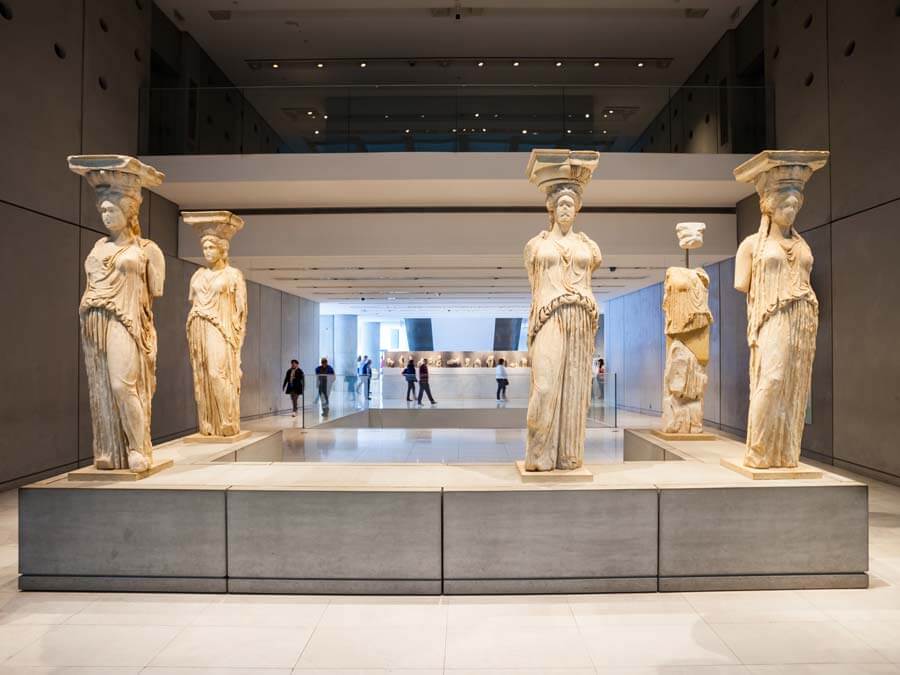
When you visit Athens, make sure to book a guided tour of the Acropolis and the Parthenon with a local expert.




